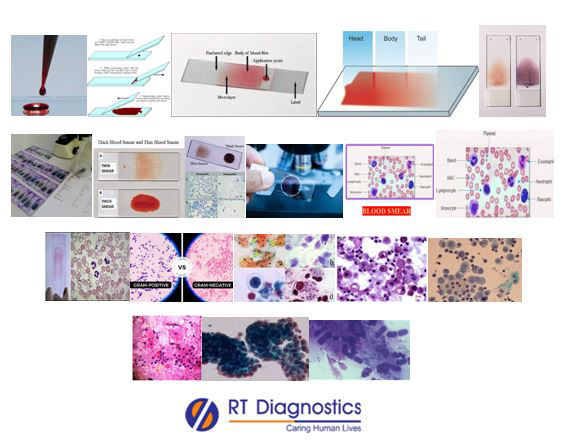Peripheral Blood Film - PBF:
Why Peripheral Blood Film Test?
CLINICAL INFORMATION
Peripheral blood film(PBF) –It is a laboratory test used for the analysis of cytology of peripheral blood cells smeared on the glass slide for microscopic studies (looks for abnormalities in the blood). Routine haematology study requires PBF analysis (which determines the relative percentage in the blood) is now becoming a lost art, which is now largely replaced by advanced automated equipment like digital blood smears, and flow cytometers. This test helps detect, diagnose and/or monitor a range of abnormalities that reflect pathology such as disorders (blood dyscrasias), deficiencies, diseases, malfunction etc. This test helps in the characterization of various clinical diseases hence used for screening purposes (eg. malaria – consists of both thin smear and thick smear preparations, filariasis, anaemia (reticulocytes), and RBC Morphological studies - MCV, MCHC, RDW, MPV, anisocytosis, poikilocytosis, anisopoikilocytosis, macrocytosis, microcytosis (due to iron deficiency anaemia), hypochromic or hyperchromasia, hyperchromia or hyperchromasia, nucleated RBCs (seen in fibrosis of bone marrow, cancers, severe anaemia, military tuberculosis, hypoxia i.e hypoxemia etc), polychromasia (increased RNA content reflects in blue staining due to immature release from bone marrow eg. reticulocytes etc), Burr cell, Target cell, Spur cell, elliptocytosis, spherocytes, teardrop cells, shistocytes (RBC fragments), Helmet cells (seen in intravascular coagulation), Howell-Jolly bodies, Cabot’s ring, Rouleaux formation, nucleated RBCs (in severe hemolysis), Henz bodies, pencil cells, differential count (eg. leukocytosis, leukocytopenia, hyper-segmented neutrophils (shift to right), bi-lobed neutrophils (in certain genetic syndromes), hairy cells, toxic granulation, Auer rods, erythrocytosis, immature WBCs, sickle cell disease, abnormal platelets (especially low blood platelet counts - thrombocytopenia), Bands -left shift (immature neutrophils in acute inflammation or infection), basophilic stippling (small granular bodies within red cell cytoplasm when there is disordered and accelerated erythropoisis), bone marrow studies, sperm count (semen analysis), gram-positive and/or gram-negative bacteria, identification of bacteria (eg. cocci, bacilli etc), AFB, histopathology, urine analysis (crystals, cast etc), stool test (blood in stools, parasites like pinworm, ova, cyst etc), identification of parasites, pap smear (identification of cancerous cells from normal cells), hemolytic-uremic syndrome (triggered by an infection in the GIT) etc. PBF is indicated in pathologies including blood disorders (RBC, WBC, Platelets), bleeding disorders, allergies, blood-related cancers, blood parasites (eg. malarial parasites – it requires both a thin smear and a thick smear preparations), lymph node swellings, hepatosplenomegaly etc. Anaemia with low MCV (microcytic) is usually seen in iron deficiency anaemia, anaemia of chronic diseases, thalassaemia (microcytosis) etc, anaemia with normal MCV (normocytic) indicates recent bleeding, anaemia of chronic diseases such as renal diseases, high HB may be due to COPD, cigarette smoking, obesity, alveolar hypotension, increased neutrophils may be due to bacterial infections, trauma, surgery, burns, haemorrhage, inflammation, infarction, myeloproliferative disorders, medications like steroids, heat strokes, patients with solid tumours etc, increased lymphocytes in infectious mononucleosis (reactive lymphocytes), viral infections, toxoplasmosis, TB, syphilis, CLL, hairy cell leukaemia, decreases lymphocytes may be due to steroid therapy, SLE, AIDS, chemotherapy etc. This test is indicated in clinical manifestations including signs and symptoms of tiredness and weakness, lack of energy, frequent infections, bone and joint pain, abnormal bleeding, swollen lymph nodes, swollen liver and/or spleen, headaches, vomiting, confusion, seizures, night sweat, weight loss, shortness of breath etc. A blood smear study can also indicate abnormalities such as liver disease, kidney disease, hypothyroidism etc. Other additional tests include flow cytometer, neubauer counting chamber, ESR, bleeding test, clotting test, HB concentration, electrophoresis (to determine haemoglobin variants), bone marrow biopsy etc.

General Instructions:
Sample Requirement: Specimen - Blood sample collected from the vein. Test Preparation: None.
NOTE - Sample for specimen collections may vary based on the patient’s condition/cases according to the patient’s presenting complaints/signs or symptoms:
SPECIMEN REQUIREMENT (Special or Rare Cases) - As instructed and guided by Physician / Clinician / Pathologist / as per Laboratory’s requirements, according to procedures and protocols.
This Multi-Specialty Clinical Referral Laboratory RT DIAGNOSTICS provides precise and accurate tests with an extensive range of testing services to the medical centres to help in the diagnosis and identification of pathology in the test specimens for infectious diseases and also to evaluate the function of organ systems of the patient. It prevents further complications and helps to stabilize and restore health to near normalcy at the earliest without delay.



